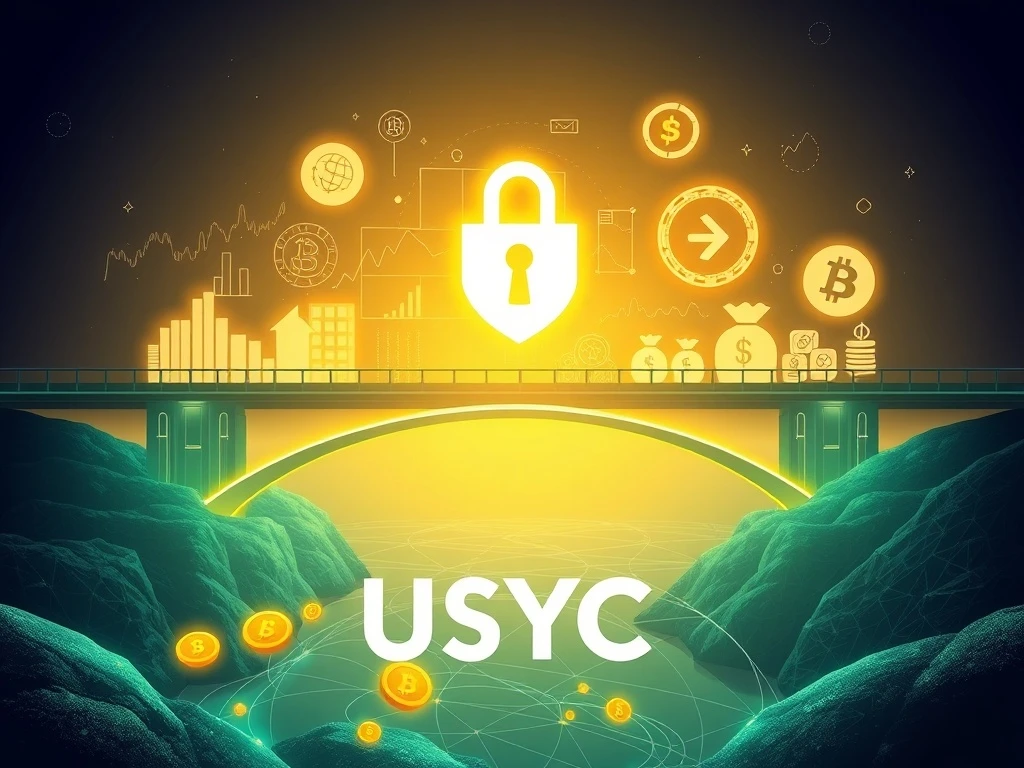Unlocking Growth: Binance USYC Integration Propels Tokenized Assets to New Heights

Are you ready to witness a monumental shift in how institutions engage with digital assets? Binance, a global leader in cryptocurrency exchanges, has just announced a groundbreaking move: the integration of Circle’s USYC token as eligible collateral for institutional over-the-counter (OTC) derivatives trading. This isn’t just another update; it’s a strategic leap forward, poised to revolutionize how sophisticated market participants manage capital and risk in the rapidly evolving world of tokenized assets. With the tokenized real-world asset (RWA) market surging past an astonishing $24 billion, this development signals a new era for institutional crypto adoption.
What is Circle USYC and Why Does It Matter?
At its core, Circle USYC is a hybrid asset designed to bridge the best of both worlds: the stability and liquidity of a stablecoin combined with the yield-generating potential of traditional Treasury-backed instruments. Imagine earning returns on your collateral without the need to convert your digital holdings into fiat or other volatile cryptocurrencies. That’s the power of USYC.
- Hybrid Asset Structure: USYC is essentially a tokenized money market fund, offering exposure to U.S. Treasuries and corporate bonds. This unique structure allows institutions to maintain liquidity while simultaneously generating yield.
- Yield Generation: By allocating holdings into interest-bearing government and corporate securities, USYC provides a novel tool for capital efficiency, allowing collateral to work harder.
- Seamless Integration: Its availability on Binance’s BNB Chain ensures smooth deployment in derivatives contracts and margin requirements for institutional clients.
This innovative approach makes Circle USYC particularly appealing for large-scale traders looking to optimize their balance sheets and enhance risk management strategies in the institutional crypto space.
Why Binance is Embracing RWA Collateral
Binance’s decision to integrate USYC is a clear indicator of its commitment to serving sophisticated market participants. As Catherine Chen, Binance’s head of VIP and Institutional division, highlighted, the goal is to deliver “more efficient and secure infrastructure tailored for sophisticated market participants.” This strategic alignment focuses on several key benefits:
- Enhanced Capital Efficiency: Institutions can now deploy yield-generating assets as collateral, freeing up capital that would otherwise sit idle.
- Diversified Collateral Options: Expanding the range of acceptable collateral beyond traditional cryptocurrencies attracts a broader spectrum of institutional clients.
- Reduced Counterparty Risk: The use of tokenized assets in off-exchange derivatives and OTC settlement services streamlines processes and minimizes risks associated with traditional settlement methods.
- Bridging TradFi and Crypto: By supporting assets like USYC, Binance reinforces its role as a vital bridge, offering institutions a seamless transition between fiat-backed tokens and digital assets.
This move isn’t just about adding a new token; it’s about fundamentally improving the operational framework for institutional players in the digital asset ecosystem, leveraging the benefits of RWA collateral.
The Astonishing Rise of Tokenized Assets
The integration of USYC comes at a time when the tokenized real-world asset (RWA) market is experiencing explosive growth. Data from RWA.xyz paints a compelling picture:
Tokenized RWA assets (excluding stablecoins) have surged from $15.2 billion in December 2024 to an impressive $24 billion by June 2025. This nearly 60% increase in just six months underscores the escalating institutional interest in blockchain-based collateral and yield-generating digital instruments.
This growth isn’t just theoretical; nearly $700 million in U.S. government debt is now represented on-chain through mechanisms like reverse repos, with a significant portion linked to USYC. Analysts widely believe that Binance’s adoption of USYC will further accelerate the onboarding of tokenized assets, especially as the demand for efficient collateral solutions continues to intensify across global financial markets. The trajectory is clear: tokenized assets are becoming a cornerstone of future finance.
Impact on Institutional Crypto Markets and Beyond
Binance’s strategic embrace of USYC, alongside other tokenized RWAs like cUSDO, signifies a broader shift in the institutional crypto landscape. These integrations are designed to enhance off-exchange derivatives and OTC settlement capabilities, crucial for large-volume traders.
The market reception has been largely positive, albeit with a healthy dose of caution. While the yield-generating features of USYC are undeniably attractive for institutions seeking passive income, challenges such as evolving regulatory scrutiny and inherent market volatility remain considerations. However, the prevailing sentiment is that the growing adoption of RWAs like USYC indicates a fundamental shift in how institutions perceive digital assets – moving beyond mere speculative investments to viewing them as sophisticated tools for risk mitigation and revenue generation.
This development also aligns with broader industry efforts to improve interoperability between traditional and digital financial systems. By facilitating the use of tokenized Treasury products, which have now reached $1.7 billion in 2025, Binance is not only enhancing asset efficiency and liquidity management but also potentially paving the way for wider mainstream adoption of tokenized assets.
A New Horizon for Digital Finance
Binance’s integration of Circle’s USYC marks a pivotal moment in the evolution of institutional finance within the digital asset space. It’s a testament to the growing maturity of the crypto market and its increasing alignment with traditional financial principles of capital efficiency and risk management. As tokenized assets continue their impressive ascent, this collaboration highlights the immense potential for blockchain technology to transform how global institutions manage their portfolios and engage with digital collateral. This move solidifies Binance’s position at the forefront of innovation, driving the convergence of TradFi and DeFi and setting a powerful precedent for the future of finance.
Frequently Asked Questions (FAQs)
What is USYC and how does it differ from a stablecoin?
USYC is a hybrid token developed by Circle that combines the liquidity of a stablecoin with the yield-generating potential of traditional financial assets. Unlike a typical stablecoin which aims for price stability against a fiat currency, USYC represents a tokenized money market fund with exposure to U.S. Treasuries and corporate bonds, allowing holders to earn yield directly on their digital collateral.
Why is Binance integrating USYC for institutional clients?
Binance is integrating USYC to enhance its institutional product offerings by providing more efficient and secure infrastructure. This allows institutional clients to use a yield-generating asset as collateral for OTC derivatives trading, improving capital efficiency, diversifying collateral options, and streamlining settlement processes.
What are Real-World Assets (RWAs) in the context of this integration?
Real-World Assets (RWAs) refer to tangible or intangible assets from the traditional financial world that are tokenized and brought onto a blockchain. In this context, USYC is an RWA because it represents exposure to U.S. Treasuries and corporate bonds on-chain, allowing institutions to leverage these traditional assets within the digital asset ecosystem.
How has the tokenized RWA market grown recently?
The tokenized Real-World Asset (RWA) market, excluding stablecoins, has seen significant growth, surging from $15.2 billion in December 2024 to $24 billion by June 2025. This substantial increase highlights rising institutional interest and adoption of blockchain-based collateral and yield-generating digital instruments.
What are the benefits for institutions using USYC as collateral?
Institutions using USYC as collateral can benefit from enhanced capital efficiency by earning yield on their collateral, improved liquidity management, reduced counterparty risks through streamlined settlement, and diversified collateral options beyond traditional cryptocurrencies. It allows them to maintain digital asset exposure while generating returns from traditional finance instruments.






